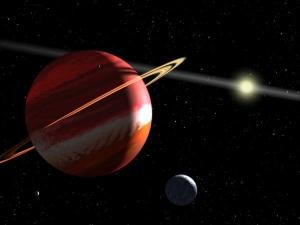Instead of watching the sky, the researchers from Spain and Great Britain dug into the archive of observations of a previous planet discovered in the system and identified a pattern that indicated a gravitational disturbance by a new planet * This is the smallest planet discovered so far

Astronomers from Spain and Great Britain have discovered a "terrestrial" planet orbiting a star in the constellation Leo. The new planet, located at a distance of about 30 light years, is 5 times heavier than Earth but is the smallest found so far. A full day on the new planet would be equivalent to three weeks on Earth.
The team, which includes astronomers from the Spanish Research Council (CSOIS) together with the French astronomer Jean-Philippe Bailleau, a visiting researcher at University College London, discovered the planet using a prediction model designed for this. The simulations showed that the planet, named GJ 436c orbits the star CJ 436 for 5.2 Earth days, and it completes its orbit around its axis in 4.2 Earth days. On Earth, a whole day - from sunset to sunset fits nicely with the duration of the self-rotation. On the new planet, these two periods are not the same because the length of the day and the length of the year are quite close to each other. For this reason, a full day on the planet will last four laps (planetary years) or about 22 Earth days.
The study recently published in the Astrophysical Journal predicts the presence of smaller planets in systems where inner planets have already been discovered, and which cause slight changes in the orbits of these planets. A reanalysis of radial velocity data archives made it possible to identify the signal that corresponds to the simulation and indicates the existence of a planet that influences the inner planet, and this means that for every two revolutions of the known planet, the new planet completes one revolution.
CSIS principal investigator Ignacy Rivas said: “After final confirmation, this planet may be the smallest discovered so far. It will be the first to be discovered due to its gravitational influence on another planet in the system. Because of this, the research opens a new path that may lead to the discovery of even smaller planets in the near future, when the goal is ultimately to find worlds more and more similar to Earth."

4 תגובות
A draft, of course
The research bias was published on March 4 this year at this address:
https://www.hayadan.org.il/new-rocky-planet-found-in-constellation-leo-1304084/
Here they have not yet published anything about the rate of rotation of the planet around itself. The claim about calculating the duration of the star's rotation around itself seems surprising to me too and I would love to know how they arrived at it.
All well and good, but according to what can you calculate the rate of rotation of the planet around itself?
The calculations of the days and holocausts for the earth made me yawn vigorously.
The model and simulation are nice, I suppose, but the point of them right now is only as some future promise of something tangible.
I very much hope that this method will become a cheap and completely automatic way of finding "interesting" places in the universe which will then lead directly to the direction of the telescopes and the confirmation of the simulations for Beech.
My personal experience with models is not necessarily positive and I tend to be suspicious of them even if they look innocent. Models are theory and in theory there could really be a planet there. In practice, there could be a large, stale turtle egg.